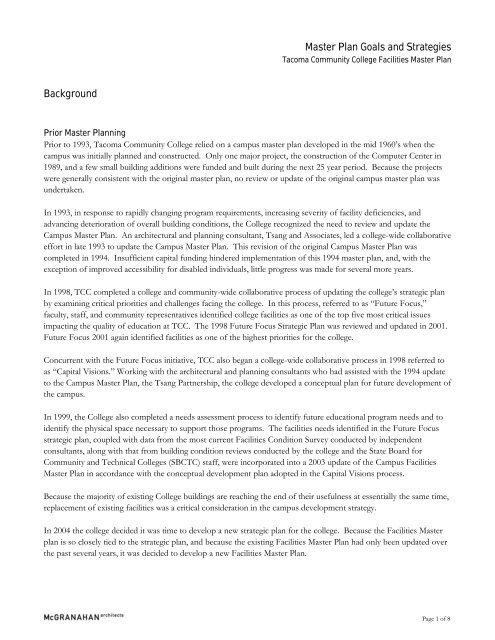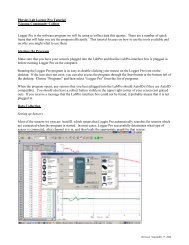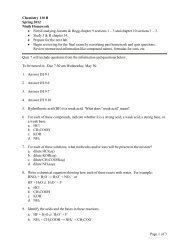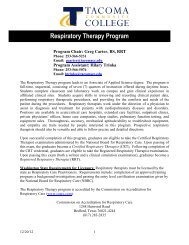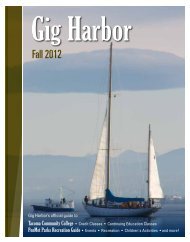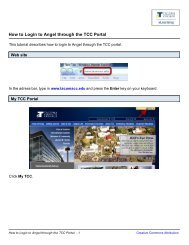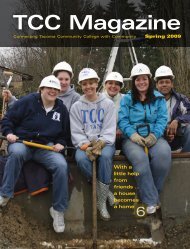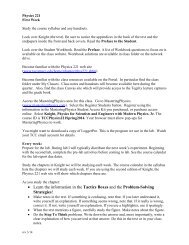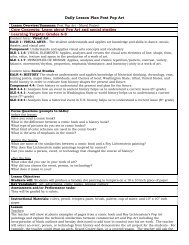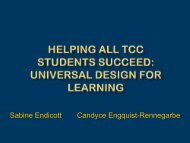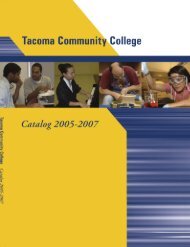Master Plan Goals and Strategies Background - Tacoma Community ...
Master Plan Goals and Strategies Background - Tacoma Community ...
Master Plan Goals and Strategies Background - Tacoma Community ...
You also want an ePaper? Increase the reach of your titles
YUMPU automatically turns print PDFs into web optimized ePapers that Google loves.
<strong>Master</strong> <strong>Plan</strong> <strong>Goals</strong> <strong>and</strong> <strong>Strategies</strong><strong>Tacoma</strong> <strong>Community</strong> College Facilities <strong>Master</strong> <strong>Plan</strong><strong>Background</strong>Prior <strong>Master</strong> <strong>Plan</strong>ningPrior to 1993, <strong>Tacoma</strong> <strong>Community</strong> College relied on a campus master plan developed in the mid 1960’s when thecampus was initially planned <strong>and</strong> constructed. Only one major project, the construction of the Computer Center in1989, <strong>and</strong> a few small building additions were funded <strong>and</strong> built during the next 25 year period. Because the projectswere generally consistent with the original master plan, no review or update of the original campus master plan wasundertaken.In 1993, in response to rapidly changing program requirements, increasing severity of facility deficiencies, <strong>and</strong>advancing deterioration of overall building conditions, the College recognized the need to review <strong>and</strong> update theCampus <strong>Master</strong> <strong>Plan</strong>. An architectural <strong>and</strong> planning consultant, Tsang <strong>and</strong> Associates, led a college-wide collaborativeeffort in late 1993 to update the Campus <strong>Master</strong> <strong>Plan</strong>. This revision of the original Campus <strong>Master</strong> <strong>Plan</strong> wascompleted in 1994. Insufficient capital funding hindered implementation of this 1994 master plan, <strong>and</strong>, with theexception of improved accessibility for disabled individuals, little progress was made for several more years.In 1998, TCC completed a college <strong>and</strong> community-wide collaborative process of updating the college’s strategic planby examining critical priorities <strong>and</strong> challenges facing the college. In this process, referred to as “Future Focus,”faculty, staff, <strong>and</strong> community representatives identified college facilities as one of the top five most critical issuesimpacting the quality of education at TCC. The 1998 Future Focus Strategic <strong>Plan</strong> was reviewed <strong>and</strong> updated in 2001.Future Focus 2001 again identified facilities as one of the highest priorities for the college.Concurrent with the Future Focus initiative, TCC also began a college-wide collaborative process in 1998 referred toas “Capital Visions.” Working with the architectural <strong>and</strong> planning consultants who had assisted with the 1994 updateto the Campus <strong>Master</strong> <strong>Plan</strong>, the Tsang Partnership, the college developed a conceptual plan for future development ofthe campus.In 1999, the College also completed a needs assessment process to identify future educational program needs <strong>and</strong> toidentify the physical space necessary to support those programs. The facilities needs identified in the Future Focusstrategic plan, coupled with data from the most current Facilities Condition Survey conducted by independentconsultants, along with that from building condition reviews conducted by the college <strong>and</strong> the State Board for<strong>Community</strong> <strong>and</strong> Technical Colleges (SBCTC) staff, were incorporated into a 2003 update of the Campus Facilities<strong>Master</strong> <strong>Plan</strong> in accordance with the conceptual development plan adopted in the Capital Visions process.Because the majority of existing College buildings are reaching the end of their usefulness at essentially the same time,replacement of existing facilities was a critical consideration in the campus development strategy.In 2004 the college decided it was time to develop a new strategic plan for the college. Because the Facilities <strong>Master</strong>plan is so closely tied to the strategic plan, <strong>and</strong> because the existing Facilities <strong>Master</strong> <strong>Plan</strong> had only been updated overthe past several years, it was decided to develop a new Facilities <strong>Master</strong> <strong>Plan</strong>.Page 1 of 8
<strong>Master</strong> <strong>Plan</strong> <strong>Goals</strong> <strong>and</strong> <strong>Strategies</strong><strong>Tacoma</strong> <strong>Community</strong> College Facilities <strong>Master</strong> <strong>Plan</strong>In 2005 the college hired McGranahan Architects to assist the college in developing a new Facilities <strong>Master</strong> plan thatcomplements, supports, <strong>and</strong> dovetails with the new college strategic plan <strong>and</strong> emerging community <strong>and</strong> student needs.Primary funding for capital needs over the next several biennia will depend on legislative approval of the SBCTCcapital budget request in each biennium. Additionally, the college is aggressively pursuing other capital fundingsources including alternative financing, identifying potential development partners, <strong>and</strong> undertaking a capital fundraising campaign.Commitment to InnovationIn the Spring of 2005, TCC completed a new Strategic <strong>Plan</strong> entitled “Commitment to Innovation: 2005-2010”. TheStrategic Initiatives that were formed from that process are developed around 6 themes: Learning, Student Support,Diversity, <strong>Community</strong>, Excellence & Innovation, <strong>and</strong> Learning & Working Environment.The Facilities <strong>Master</strong> <strong>Plan</strong> Committee worked with these Strategic Initiatives <strong>and</strong> identified a variety of <strong>Master</strong> <strong>Plan</strong><strong>Goals</strong> <strong>and</strong> <strong>Strategies</strong> to implement in future building <strong>and</strong> campus development. These are included in their entirety togive a full underst<strong>and</strong>ing of the breadth <strong>and</strong> depth of exploration that occurred. The <strong>Goals</strong> <strong>and</strong> <strong>Strategies</strong> are alsoincluded in Development Recommendations where they are color coded to identify ways they support the priorityprojects resulting from the Facilities <strong>Master</strong> <strong>Plan</strong> process.Page 2 of 8
<strong>Master</strong> <strong>Plan</strong> <strong>Goals</strong> <strong>and</strong> <strong>Strategies</strong><strong>Tacoma</strong> <strong>Community</strong> College Facilities <strong>Master</strong> <strong>Plan</strong>TCC <strong>Master</strong> <strong>Plan</strong> <strong>Goals</strong> <strong>and</strong> <strong>Strategies</strong><strong>Master</strong> planning should build upon TCC’s Strategic Initiatives with Facilities Related <strong>Goals</strong> & <strong>Strategies</strong>• They must be applicable to the physical development of the campus• The goals will be tested through measurability/achievability…Scenario planning <strong>and</strong> application• They should define the unique aspects <strong>and</strong> elements of TCC <strong>and</strong> its visionThe narrative that follows the title of each of the Strategic Initiatives is taken from “Commitment to Innovation”.LEARNINGAt TCC, we are all lifelong learners. We progress <strong>and</strong> acquire skills, knowledge <strong>and</strong> underst<strong>and</strong>ing in an invigorating<strong>and</strong> technologically advanced learning environment. Together we engage in inquiry, construct meaning <strong>and</strong> developconnections that improve individual lives <strong>and</strong> promote social progress.As a learning college we use creative, student-centered instructional <strong>and</strong> alternative delivery methodologies, <strong>and</strong> werespond to emerging <strong>and</strong> evolving student <strong>and</strong> community needs. TCC learners are equipped to be ethical decisionmakers who contribute culturally, economically <strong>and</strong> socially to the public good.<strong>Goals</strong>:1. Provide student-centered instructional <strong>and</strong> alternative delivery methodologies.2. Develop connections that improve individual lives <strong>and</strong> promote social progress.3. Deliver support services that enhance student success, including realistic <strong>and</strong> complete assessment of learningneeds <strong>and</strong> strengths.<strong>Strategies</strong>:1.1 Implement a process to determine the optimum type <strong>and</strong> proportion of teaching/learning spaces.1.2 Promote a learning environment that provides a simulation of real-world settings <strong>and</strong> brings togetherdisparate programs <strong>and</strong> disciplines for a synergistic learning environment.1.3 Provide for asynchronous learning outside the classroom (wireless network, distance ed., formal &informal study settings, student/faculty learning support services <strong>and</strong> interaction1.4 Provide support for K-12 partnerships, Running Start, Fresh Start <strong>and</strong> University partnerships toprovide options for students2.1 Create master planning zones that support academic/program groupings <strong>and</strong> interrelationshipsamong similar programs.2.2 Include spaces that support collaborative inquiry & project-based learning with shared study areas<strong>and</strong> informal social spaces near lecture rooms <strong>and</strong> faculty offices.2.3 Complete program relationship matrix to determine frequency <strong>and</strong> effectiveness of intra-programconnections <strong>and</strong> need for proximity <strong>and</strong> shared space.2.4 Consolidate college administrative offices. Staff are currently spread around campus.3.1 Provide intensive advising <strong>and</strong> interdepartmental collaboration to sustain students’ clearly definededucational <strong>and</strong> professional pathways, <strong>and</strong> support transition to <strong>and</strong> through TCC.3.2 Create a learning support service center in building 7.Page 3 of 8
<strong>Master</strong> <strong>Plan</strong> <strong>Goals</strong> <strong>and</strong> <strong>Strategies</strong><strong>Tacoma</strong> <strong>Community</strong> College Facilities <strong>Master</strong> <strong>Plan</strong>STUDENT SUPPORTTCC underst<strong>and</strong>s the range of students’ needs <strong>and</strong> goals <strong>and</strong> provides dynamic support systems to foster resilience<strong>and</strong> persistence. We develop students’ ability to navigate within the learning environment while helping studentsdiscover <strong>and</strong> achieve their potential.TCC delivers support services that enhance student success, including realistic <strong>and</strong> complete assessment of learningneeds <strong>and</strong> strengths. Quality advising <strong>and</strong> interdepartmental collaboration sustain students’ clearly definededucational <strong>and</strong> professional pathways, <strong>and</strong> support transition to <strong>and</strong> through TCC. Together with our communitypartners we create the opportunity for learner transformation.<strong>Goals</strong>:4. Provide dynamic support systems to foster resilience <strong>and</strong> persistence.5. Address <strong>and</strong> support the 5 phases of a student’s interface with the College: pre-admission, enrollment,matriculation, retention/learning services, transition<strong>Strategies</strong>:4.1 Make inquiry <strong>and</strong> learning tools more accessible in more locations around the campus.5.1 Consolidate Student Services into a “One Stop Center” to provide better service <strong>and</strong> eliminatefrustration <strong>and</strong> confusion.5.2 Deliver some Student Services around the campus in ways that are transparent to students.5.3 Foster availability of faculty to students (by locating faculty offices near programs or educationalresources)5.4 Integrate some Student Services around the campus in strategic locations (Library, Common StudyAreas, Student Center, Daycare, etc.)5.5 Develop students’ ability to navigate within the learning environment while helping students discover<strong>and</strong> achieve their potential.Page 4 of 8
<strong>Master</strong> <strong>Plan</strong> <strong>Goals</strong> <strong>and</strong> <strong>Strategies</strong><strong>Tacoma</strong> <strong>Community</strong> College Facilities <strong>Master</strong> <strong>Plan</strong>DIVERSITYTCC values <strong>and</strong> promotes diversity. Using persistent <strong>and</strong> intentional recruitment strategies, TCC achieves a staff,faculty <strong>and</strong> student population that reflects the variety of cultures, learning styles, <strong>and</strong> life experiences of our largercommunity. TCC engages in college-wide efforts, including conversations, mentoring, training opportunities <strong>and</strong>internal promotion to support a broad <strong>and</strong> meaningful diversity. Our innovative curriculum <strong>and</strong> communityinvolvement engenders an open academic <strong>and</strong> professional pathway to exp<strong>and</strong>ed opportunities.Our passion for diversity positions TCC as a conduit between neighborhood schools <strong>and</strong> global universities <strong>and</strong>businesses. TCC’s commitment to diversity makes the college a model for an excellent <strong>and</strong> rigorous open-dooreducation which creates social justice <strong>and</strong> equality.<strong>Goals</strong>:6. Provide a physical environment that encourages exchange of experience, knowledge <strong>and</strong> ideas.7. Promote social justice <strong>and</strong> equality<strong>Strategies</strong>:6.1 Design <strong>and</strong> support programs <strong>and</strong> spaces that encourage interaction. (Academic, creative, social &recreational.)6.2 Develop facilities that are inviting, culturally inclusive <strong>and</strong> reflect the cultures on campus.6.3 Consider buildings themselves as teaching tools that reflect multi-cultural contributions to design.7.1 Use adjacencies of programs to bring together diverse groups (e.g. recent heart health class or placinggeriatric fitness next to Child Care as way to find common ground)7.2 Provide spaces <strong>and</strong> functions that invite the community to the campus7.3 Consider the integration of competitive sports in an academic communityPage 5 of 8
<strong>Master</strong> <strong>Plan</strong> <strong>Goals</strong> <strong>and</strong> <strong>Strategies</strong><strong>Tacoma</strong> <strong>Community</strong> College Facilities <strong>Master</strong> <strong>Plan</strong>COMMUNITYTCC is a diverse, collaborative organization engaged in synergistic relationships with the broader community it serves.We cultivate student-focused strategic partnerships with K-12 districts, four-year institutions, <strong>and</strong> employers. Thecollege seeks the community’s wisdom through active advisory committees, mentorship, service learning <strong>and</strong> realworldexperiences for students, staff <strong>and</strong> faculty.We present a welcoming face to our community through our accessible <strong>and</strong> attractive campus <strong>and</strong> reach out to ourdiverse communities through campus events <strong>and</strong> activities.<strong>Goals</strong>:8. Provide a well maintained communication infrastructure involving staff, students <strong>and</strong> the community to confirmthat facilities are supporting the College mission. Ensure that communication mechanisms are in place to enablethe College to respond to the desires of the community.9. Serve the evolving needs of the community <strong>and</strong> assist our constituencies in identifying needs <strong>and</strong> responding tothem.10. Optimize the development of exterior space to create a unique campus that is highly visible, attractive <strong>and</strong>engaging.11. Support community use of College facilities (considerations: wayfinding, parking infrastructure, security)<strong>Strategies</strong>:8.1 The College will seek the community’s input through the Board of Trustees, the Foundation, theMulticultural Advisory Council, community stakeholder groups <strong>and</strong> partnerships with industry <strong>and</strong>practitioners to assess facility needs <strong>and</strong> trends.8.2 Utilize Satellite campuses to strengthen service to the community.9.1 Engage partners of the College in identifying community needs <strong>and</strong> community use of Collegefacilities. (examples would be: convention type space, performing arts space)9.2 <strong>Plan</strong> for the development of the Gig Harbor Campus.10.1 Capitalize on the campus’ natural features <strong>and</strong> neighborhood location.10.2 Identify locations for social interaction <strong>and</strong> others for introspection10.3 <strong>Plan</strong> for strategic placement of public art on campus11.1 Establish a hierarchy of recognizable gateways to campus, visible signage <strong>and</strong> “curb appeal” along12 th , 19 th , Mildred <strong>and</strong> Pearl Streets.11.2 Create campus edges that indicate a collegial setting.Page 6 of 8
<strong>Master</strong> <strong>Plan</strong> <strong>Goals</strong> <strong>and</strong> <strong>Strategies</strong><strong>Tacoma</strong> <strong>Community</strong> College Facilities <strong>Master</strong> <strong>Plan</strong>EXCELLENCE AND INNOVATIONTCC holds the highest expectations for the institution, faculty, staff <strong>and</strong> students. We have high learning <strong>and</strong>performance st<strong>and</strong>ards <strong>and</strong> embolden students <strong>and</strong> staff to achieve them through effective professional <strong>and</strong>leadership development. TCC recognizes, celebrates, <strong>and</strong> rewards achievement in a climate that supports authenticity<strong>and</strong> reinforces trust <strong>and</strong> optimism.We are creative, innovative, <strong>and</strong> inclusive in setting <strong>and</strong> achieving our goals <strong>and</strong> identifying new resources. TheCollege nurtures cooperative interdepartmental work <strong>and</strong> encourages original ideas <strong>and</strong> contributions arising fromindividual passion <strong>and</strong> teamwork.<strong>Goals</strong>:12. Campus <strong>and</strong> facility development should reflect high learning <strong>and</strong> performance st<strong>and</strong>ards.13. The College will provide professional development resources to maintain high st<strong>and</strong>ards <strong>and</strong> adoption of newlearning technologies.<strong>Strategies</strong>:12.1 TCC will endeavor to provide the most current <strong>and</strong> emerging technologies in order to removebarriers from the educational environment <strong>and</strong> prepare students for the workplace settings. Establishprotocols for technology provisions during Predesign by program or building type.12.2 The College will conduct regular reviews to ensure that technology is current <strong>and</strong> flexible toaccommodate anticipated future needs. Coordinate these reviews with facilities planning <strong>and</strong> fundingrequests.13.1 Improve the Teaching/Learning Center.Page 7 of 8
<strong>Master</strong> <strong>Plan</strong> <strong>Goals</strong> <strong>and</strong> <strong>Strategies</strong><strong>Tacoma</strong> <strong>Community</strong> College Facilities <strong>Master</strong> <strong>Plan</strong>LEARNING & WORKING ENVIRONMENTAll of TCC’s sites are student-friendly facilities that are functional, safe <strong>and</strong> attractive learning <strong>and</strong> workingenvironments. The college’s pleasant appearance reflects the college’s core values <strong>and</strong> the excellent quality ofinstruction. The College has the human, fiscal <strong>and</strong> technological resources to be a learning environment where peoplemeet, create, collaborate, <strong>and</strong> socialize.Our organizational <strong>and</strong> technological infrastructure utilizes efficient operational processes that effectively support anexcellent learning, teaching <strong>and</strong> working environment<strong>Goals</strong>:14. Provide technologically advanced <strong>and</strong> diverse learning environment types to support multiple teaching - learningmodalities <strong>and</strong> provide maximum accessibility.15. Develop circulation <strong>and</strong> parking systems that are accessible, functional <strong>and</strong> acknowledge alternative modes oftransportation.16. Develop a comprehensive physical campus infrastructure that supports current needs <strong>and</strong> systems whileanticipating emerging technologies <strong>and</strong> future growth.17. For the purpose of wayfinding <strong>and</strong> orientation, give distinct identity (within guidelines) to buildings <strong>and</strong> campuszones that relate to the programs or activities they represent. Include consideration of the quality <strong>and</strong> clarity ofthe experience of approaching the College from off-campus.18. All TCC capital projects will strive to meet LEED (Leadership in Energy <strong>and</strong> Environmental Design) st<strong>and</strong>ards<strong>and</strong> the physical development of the campus will utilize the most effective means to be good stewards of theenvironment, natural resources <strong>and</strong> the financial resources available.<strong>Strategies</strong>:14.1 TCC will endeavor to provide the most current technologies in order to remove barriers from theeducational environment <strong>and</strong> prepare students for the workplace settings.14.2 Consider future use <strong>and</strong> development of the reserve property as a potential nature reserve forresearch <strong>and</strong> preservation.14.3 Buildings should be seen as living, working structures with intrinsic art, not just applied.15.1 Improve campus circulation by creating clear campus circulation pathways that include pathhierarchy, guidelines for pathway connections to facility entries <strong>and</strong> logical environmental graphicsprogram.15.2 Develop a motor pool that integrates in a more discreet way with the campus settings15.3 Develop discreet traffic pattern for service vehicles <strong>and</strong> operations (garbage, deliveries, vendors &recycling)16.1 On–site utilities will be located <strong>and</strong> sized strategically to minimize effects on campus operationswhile optimizing provisions for future planned development.Page 8 of 8


